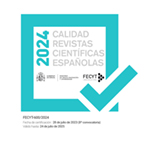A Corpus-Based Analysis of Deontic Modality of Obligation and Prohibition in Arabic/English Constitutions
Resumen
Es comúnmente aceptado que el lenguaje legal debe ser formal, preciso y claro para evitar ambigüedad y malentendidos. Dado que los derechos y deberes se comunican a través de verbos modales, la claridad y precisión al traducirlas son cruciales. De no ser así, existe la posibilidad de comunicar los mensajes del texto original de forma imprecisa o que los mensajes del texto meta sean diferentes o incoherentes a los del original. Sin embargo, el uso de las expresiones modales en árabe no se atiene a normas claras y su traducción puede variar de un traductor a otro. Este artículo investiga cómo se usa la modalidad deóntica de obligación y prohibición en The Leeds Annotated Parallel Corpus of Arabic-English en comparación con The Leeds Monolingual Corpus of English Constitutions. En concreto, el artículo presenta una clasificación de estas expresiones modales e investiga las diferentes variantes léxicas que aparecen en un corpus de constituciones en árabe. El estudio utiliza herramientas de corpus para analizar las diferentes formas léxicas que se usan para la modalidad deóntica de obligación y prohibición en árabe, así como su traducción al inglés. Los resultados de este análisis se contrastan con un corpus de constituciones en inglés para dilucidar si el significado deóntico de los modales es comparable al conjunto de modales deónticos usados en constituciones en inglés. El análisis de corpus arroja una clasificación detallada de expresiones modales usadas en el corpus árabe. Asimismo, muestra que las traducciones de los modales deónticos de obligación y prohibición del árabe al inglés están influidos por las variaciones léxicas del texto original; a pesar de que las técnicas de análisis de corpus empleadas en el estudio consiguen capturar modales comparables en ambos corpus.
Descargas
Descarga artículo
Licencia
La revista Estudios de Traducción, para fomentar el intercambio global del conocimiento, facilita el acceso sin restricciones a sus contenidos desde el momento de su publicación en la presente edición electrónica, y por eso es una revista de acceso abierto. Los originales publicados en esta revista son propiedad de la Universidad Complutense de Madrid y es obligatorio citar su procedencia en cualquier reproducción total o parcial. Todos los contenidos se distribuyen bajo una licencia de uso y distribución Creative Commons Reconocimiento 4.0 (CC BY 4.0). Esta circunstancia ha de hacerse constar expresamente de esta forma cuando sea necesario. Puede consultar la versión informativa y el texto legal de la licencia.









